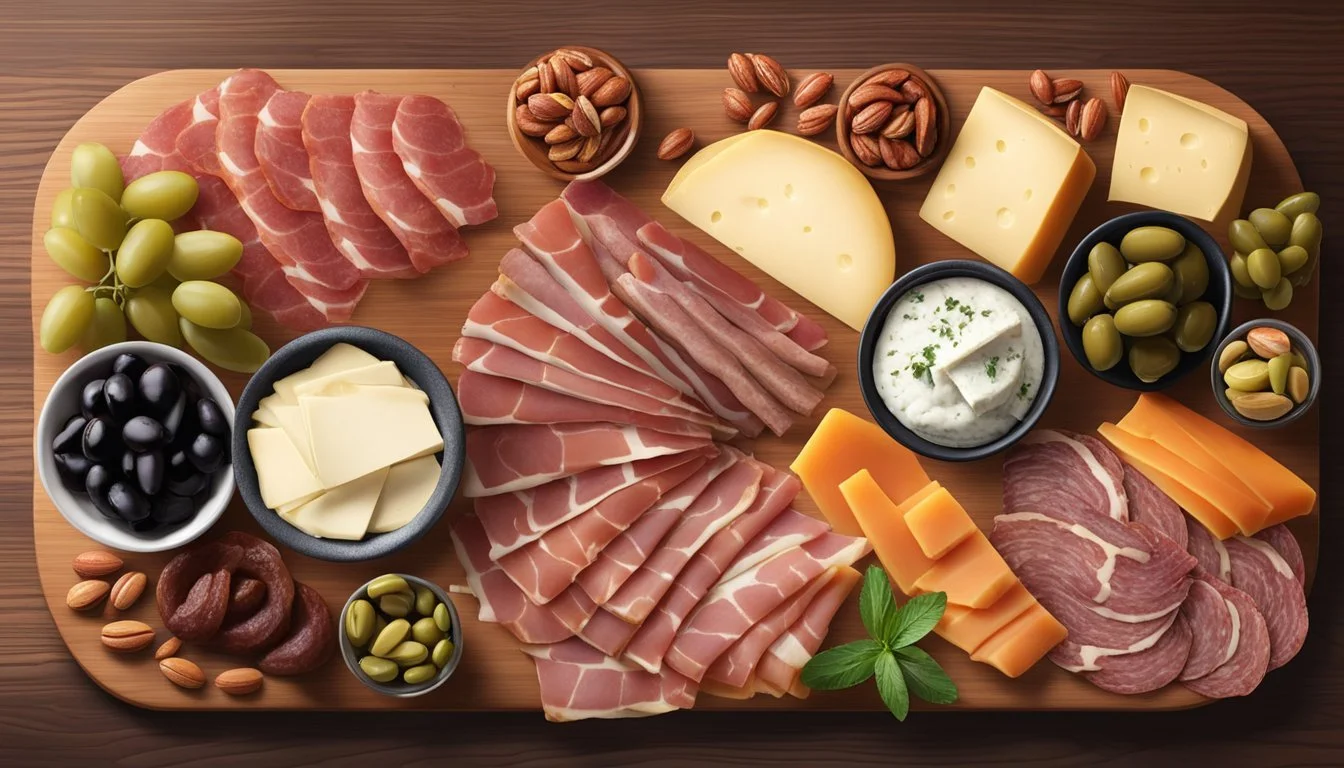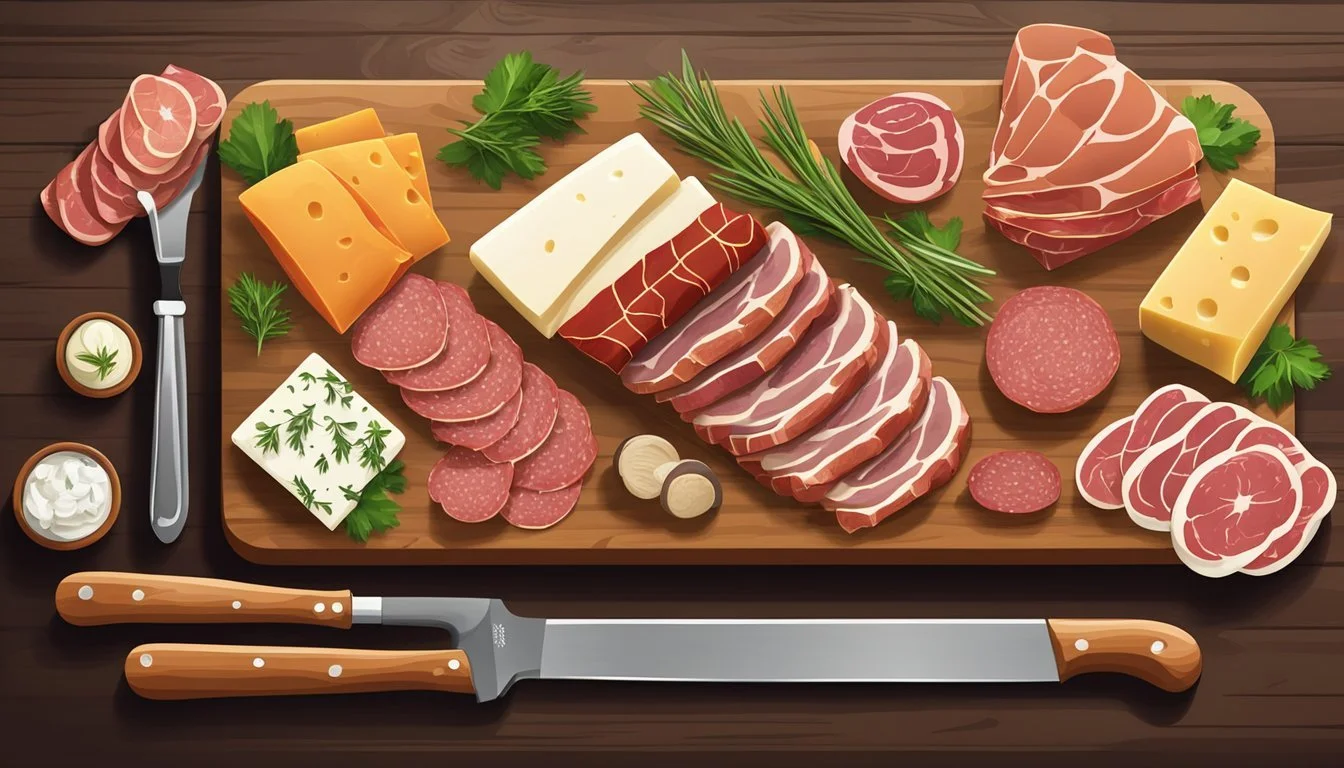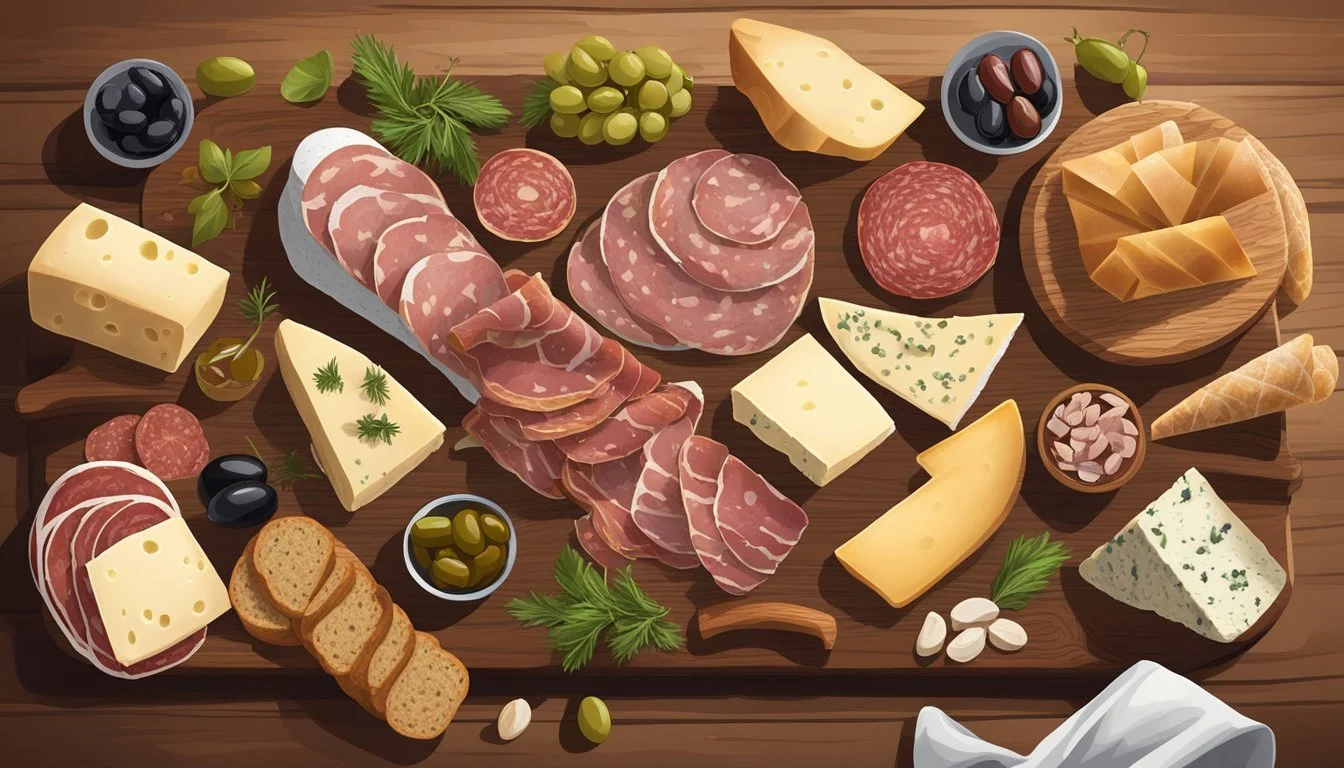How to Make the Ultimate Carnivore Diet Charcuterie Board
A Step-by-Step Guide
Creating the ultimate charcuterie board tailored to the carnivore diet can be both an art form and a celebration of simplicity. It calls for the careful selection and arrangement of high-quality meats and complementary components that adhere to the diet's strict guidelines. By focusing on animal-based products, the charcuterie (What wine goes well with charcuterie?) board becomes not just a savory platter but also a visually appealing centerpiece for any gathering.
Crafting such a charcuterie board requires attention to detail, from the choice of the meats, which should vary in texture and flavor, to the presentation. The carnivore diet prioritizes meat consumption, and so the board should showcase a variety of cured meats (What wine goes well with cured meats?) like bresaola, known for its sweet flavor and deep red color, and other selections that can include salami, chorizo, and even pork belly (What wine goes well with pork belly?) chips. Each item on the board should be sliced and arranged to make it easy for guests to help themselves.
In addition to the meat, small bowls can be used to hold complementary items such as mustards and high-fat, zero-carb dips that align with the carnivore diet, adding layers of flavor and richness to the platter. The arrangement is key; spacing the items out allows the board to look abundant and invites guests to sample the array of choices. Freshness and quality are paramount in making an ultimate carnivore diet charcuterie board that not only satisfies the dietary needs but also pleases the palate.
Understanding the Carnivore Diet
The Carnivore Diet focuses exclusively on animal products and excludes plant-based foods. This section explores the fundamental aspects of this meat-centric diet, its premise, and potential benefits.
What is the Carnivore Diet?
The Carnivore Diet is a restrictive regimen that consists primarily of meat, fish, eggs, and certain dairy products like cheese (how long does cheese last?). It operates on the principle that human ancestors thrived on animal-based diets and that modern health issues can be mitigated by returning to such a diet.
Key Characteristics:
Exclusivity: Prioritizes animal-based foods and excludes plant matter.
Simplicity: Food selection is straightforward – if it's animal-based, it's generally considered part of the diet.
Variety: Allows for various meats, including beef, chicken, pork, and seafood, as well as animal byproducts like eggs and certain dairy items.
Benefits of a Meat-Centric Diet
Adherents of the Carnivore Diet report several health benefits, although it is important to note these claims are primarily anecdotal, and more scientific research is needed.
Reported Benefits:
Weight Management: High protein and fat intake may lead to increased satiety, reducing overall calorie consumption.
Improved Digestion: Some individuals find that removing plant-based foods can alleviate digestive issues.
Simplicity in Meal Preparation: With a focus on meat, meal planning becomes less complex.
In terms of specific components, meat is the cornerstone of the diet, providing essential nutrients, such as protein, while cheese is often included for its fat content and flavor variety. However, it's imperative to select cheeses that align with the diet's principles, which typically means unprocessed options.
Choosing Your Meats
Creating the ultimate Carnivore Diet Charcuterie Board hinges on selecting a variety of high-quality meats that cater to diverse tastes and textures. The right assortment of cured meats can elevate the charcuterie experience, offering a delectable range of flavors.
Selecting High-Quality Charcuterie
For a superior charcuterie board, one focuses on the freshness and sourcing of the meats. Prosciutto and salami should have a vibrant color and a rich aroma, indicating that they have been aged properly. Authenticity plays a key role; for instance, true Iberico ham is derived from Spanish pigs and has a distinct taste. When purchasing bacon or beef, one looks for organic or pasture-raised options, as these are indicative of quality and provide robust flavors.
Varieties of Cured Meats
An expertly crafted board requires a balance of different cured meats:
Salami: A classic choice, with a firm texture and a bold taste.
Prosciutto: Delicately sliced, it brings a sweet and salty profile.
Soppressata: Known for its spiciness and higher fat content, adding a zesty flavor.
Chorizo: Adds a smoky, paprika-infused aspect.
Bresaola: Air-dried beef offering a slightly sweet taste and a leaner option.
Summer Sausage: A heavier selection, known for its garlic and mustard seeds flavor.
A varied selection caters to all palates and creates an intriguing visual appeal.
Incorporating Different Meat Textures
Texture significantly influences the enjoyment of a charcuterie board. Incorporating meats with contrasting textures makes for a more engaging experience. Here, one may choose thinly sliced ham or prosciutto for a smooth, melt-in-the-mouth sensation. Alternatively, thicker cuts of summer sausage or firm salami can provide a more substantial chew. The silky softness of high-quality bacon complements the tougher bite of dried chorizo or soppressata, ensuring that each mouthful offers a distinct and satisfying sensation.
Selecting Cheeses
Selecting the right cheeses for a carnivore diet charcuterie board is critical to balance with the assortment of meats. Cheese variety is key, with attention to pairing, textures, and health considerations.
Pairing Cheeses with Meat
When creating a charcuterie board, it's important to pair cheeses that complement the flavors of the meats. Brie and blue cheese, for instance, pair exceptionally well with rich, flavorful meats like prosciutto or salami. On the other hand, milder meats like turkey can be paired with a stronger cheese like aged cheddar to bring out its taste.
Soft cheese: Pairs with mild meats
Example: Goat cheese with turkey
Hard cheese: Complements bold, flavorful meats
Example: Gouda with salami
A Range of Cheese Textures
Incorporating a range of textures in cheese selection adds depth to a charcuterie board. A variety should include soft cheeses (What wine goes well with soft cheeses?) like cream cheese, semi-soft cheeses like gouda, hard cheeses such as aged cheddar, and very hard varieties like Parmigiano-Reggiano. Textural contrast caters to diverse palates and makes the board more interesting.
Soft: Brie, camembert
Semi-soft: Swiss, havarti
Hard: Cheddar, manchego
Very hard: Parmesan, Asiago
Cheese and Health Considerations
For individuals who follow a carnivore diet for health reasons, it's important to select cheeses that align with their dietary needs. Many cheeses, like cheddar cheese and swiss, offer a good source of protein and fat with minimal carbohydrates, making them suitable for a low-carb diet. Cheeses like gouda and brie provide a source of essential nutrients like calcium and vitamin K2.
High in protein: Swiss, cheddar
Low in lactose: Gouda, brie
High in fat, low in carbs: Suitable for carnivore and keto diets
In choosing cheeses for a carnivore diet charcuterie board, one must balance flavor pairings with meats, offer a variety of textures, and consider health benefits and dietary needs.
Adding Fresh Elements
A well-rounded carnivore diet charcuterie board benefits from the inclusion of fresh fruits and vegetables to complement the rich flavors of meats and cheeses. These elements introduce not only a variety of tastes but also provide a visual appeal and nutritional balance.
Incorporating Fruits and Vegetables
When it comes to fruits, one has multiple options that can suit the carnivore palate while still adding a fresh component. Berries such as strawberries or raspberries offer a tangy contrast to savory meats. Thinly sliced apples or pears provide a crisp, sweet balance that can help cleanse the palate. For a subtler sweetness, one might add grape clusters. Adding variety is key, so considering color, texture, and sweetness can improve both the visual and gustatory elements of the board.
Fruit Suggestions for Charcuterie Board
Strawberries (berries)
Raspberries (berries)
Apple slices
Pear slices
Grape clusters
Vegetables can also play a vital role on a carnivorously inclined board. Since traditional charcuterie garnishes like cornichons or pickles are often made from cucumbers (how long do cucumbers last?), adding slices of cucumber works well. For an earthy flair and added texture, one might include marinated mushrooms. Vegetables should be fresh, possibly with a slight pickle or marinade to complement the richness of the other items on the board.
Vegetable Suggestions for Charcuterie Board
Cucumber slices
Marinated mushrooms
The Role of Fresh Produce in Balance
Fresh produce not only adds aesthetic appeal but also creates a balanced eating experience. The freshness of fruits like apple slices and oranges contrasts with the density of meats, providing a refreshing bite in between. Meanwhile, the crunch of vegetables like cucumber can act as a palate cleanser, allowing each flavor to stand out. The inclusion of these items is essential to prevent flavor fatigue and to offer a well-rounded tasting journey.
The placement of these fresh elements is also crucial; they should be evenly distributed to provide visual balance and easy access. A board that integrates fresh produce effectively will have these items in groupings or as a garnish, complementing the main focus of the board while also standing out as appetizing options in their own right.
Complementary Foods & Condiments
While a strictly carnivore diet charcuterie board centers on meats, incorporating an array of non-meat options can cater to varied palettes when not restricted by the diet's guidelines. These additions offer additional tastes and textures that can complement the rich flavors of the chosen meats.
Crackers and Breads
Crackers and Breads provide a crunchy contrast to the succulent meats. For a grain-free option, consider:
Coconut flour flatbreads
Dips and Spreads
Dips and Spreads elevate the board's flavor profile. Include:
Sugar-free Mustard: a tangy touch that pairs well with most meats.
Homemade Dips: such as hummus or sugar-free jams in small bowls.
Olives, Nuts, and Other Delicacies
A selection of Olives, Nuts, and Other Delicacies adds variety. Ideal choices are:
Marinated olives
A bowl of mixed nuts: almonds, walnuts
Dried fruits: small servings of blueberries, strawberries, or apple slices
Building Your Board
Creating the ultimate carnivore diet charcuterie board requires careful selection of the board itself, strategic arrangement of ingredients for aesthetic appeal, and a methodical approach to assembly.
Charcuterie Board Selection
The foundation of any charcuterie spread is the charcuterie board. One must select a board that is large enough to accommodate an assortment of meats, cheeses, and other low-carb accompaniments without overcrowding. The material of the board—an elegant wooden platter or a polished marble slab—can add a touch of sophistication to the presentation.
Size: Choose based on the number of guests.
Material: Consider durability and aesthetics.
Arrangement and Presentation Tips
For a visually appealing charcuterie board, balance and variety are key. Placement matters; ensure each type of meat and cheese is accessible without any one item dominating the space. Color and texture play pivotal roles in creating an enticing display. Pair contrasting colors and textures together for an eye-catching effect.
Contrast: Arrange vibrant red meats against milder-colored cheeses.
Accessibility: Space out items evenly.
Variety: Include a selection of soft, semi-hard, and hard cheeses.
How to Assemble Your Board
Start by placing the largest items first—this typically includes blocks or slices of cheese. Then, thoughtfully arrange the cured meats, folding them artistically or fanning them out. Intersperse with low-carb snacks such as nuts or olives. Lastly, if including any condiments like mustards, opt for small bowls to prevent them from running into other components.
Large Items: Begin with cheeses and meats.
Low-Carb Snacks: Add nuts, olives, or pickles.
Condiments: Serve in separate small bowls to avoid mixing.
Properly assembling a charcuterie board for the carnivore diet is a reflection of careful ingredient selection, an eye for artistic presentation, and the understanding of how each component complements the other. With these guidelines, anyone can compose a truly impressive carnivore charcuterie board.
Hosting and Serving
Constructing the ultimate carnivore diet charcuterie board requires attention to detail in both preparation and presentation to ensure guests receive the best dining experience.
Prep and Total Time Considerations
Effective hosting begins with preparation. Prep time for a charcuterie board can vary vastly, but it's prudent to allocate at least 30 minutes to properly assemble the board. Total time may increase depending on the complexity and size of the board. A sufficient prep time allows one to carefully curate the selection of meats and accommodate any specific cooking or cutting techniques that contribute to the overall dining experience.
Serving Size and Guest Preferences
While considering serving size, aim to include enough variety to cater to different preferences, ensuring that each guest can enjoy multiple options. A helpful trick is estimating about 2 to 3 ounces of meat per person when preparing for parties. Understanding guest preferences beforehand helps in curating a selection that aligns with the carnivore diet yet appeals to all.
Accompaniments and Utensils
For a charcuterie board focusing on carnivorous fare, include a range of accompaniments such as mustards or carnivore-approved dips served in small bowls. Each item should be easily accessible, and providing appropriate utensils enhances the experience. A set of cheese knives, spoons, and picks or toothpicks ensures that guests can serve themselves with ease. Have plenty of napkins on hand as well as decorative elements like sprigs of herbs to add visual appeal without detracting from the meat-centric theme.
Advanced Charcuterie Concepts
When one progresses beyond the basic assembly of a charcuterie board, the focus shifts to thematic creativity and thoughtful pairing, elevating the carnivore diet experience to new heights.
Creative Twists and Theme Boards
Creative twists on a carnivore diet charcuterie board involve incorporating a variety of high-quality deli meats (how long do deli meats last?)with unique presentations. Chefs might consider rolling or folding meats into intricate shapes or using skewers and picks to create visually appealing structures. Eggs can serve as a protein-rich garnish, while boiled, deviled, or even as egg salads presented in distinct patterns.
Herbs: Use fresh herbs like rosemary or thyme to add aroma and decorate the board, placing them strategically around meat cuts.
Garnishing with Veggies: While strictly carnivorous diets omit plant matter, those incorporating more variety might use veggies such as pickled peppers or cucumbers for color contrast and palate cleansing.
Simplicity vs. Complexity: Sometimes a simple presentation focusing on the quality and variety of two to three meats can surpass a complex but unfocused arrangement.
Pairing with Drinks
The act of pairing meat selections with the appropriate drinks can enhance the overall tasting experience. Strong, robust flavors from meats like bresaola or salami pair well with full-bodied red wines, while lighter meats may align with white wines or crisp beers.
Full-Bodied Red Wines: Ideal for heavier, cured meats; they complement the rich flavors without overpowering.
Lighter Wines and Beers: Pair with milder deli meats to maintain a balance of freshness and savoriness.
List of Meat Types with Wine and Beer Pairings:
Heavier Cured Meats
Wine Pairing: Full-Bodied Red (Cabernet)
Beer Pairing: Dark Ale, Stout
Mild Deli Meats
Wine Pairing: Light White (Sauvignon)
Beer Pairing: Lager, Pilsner
In summary, an ultimate carnivore diet charcuterie board infused with advanced concepts becomes a curated art form. It brings together form, flavor, and pairings in a symphony of taste that aligns with the robust simplicity of the carnivore diet.
Storing and Preservation
When creating a charcuterie board as part of a carnivore diet, one must address the proper storage and preservation of meats to ensure longevity and safety. This is essential not only for taste and quality but also for reducing food waste and maintaining hygienic standards.
Leftover Management
Storing Leftovers: Once the charcuterie board has been enjoyed, any leftovers should be stored promptly in the fridge. Meats and cheeses should be wrapped carefully in cling film or placed in airtight containers to maintain freshness and prevent cross-contamination. Ideally, one should consume leftovers within 3-4 days.
Meats: Refrigerate at or below 40°F.
Cheeses: Wrap in wax paper, then place in a plastic bag.
Dishes: If meats and cheeses were served on dishes, these dishes should be cleaned before reuse.
Safety and Hygiene Practices
Sanitation Measures: Maintaining cleanliness is pivotal when handling and preserving foods on a carnivore diet. Users must wash their hands thoroughly before and after touching meat and cheese, and surfaces should be disinfected frequently.
Hygiene: Use soap and hot water to clean hands and surfaces.
Eggs: If eggs are included on the board, they should be stored separately to prevent cross-contamination.
Utensils and Napkins: All utensils should be washed with hot, soapy water, and disposable napkins should be provided to guests to ensure personal hygiene.
Conclusion
Creating the ultimate carnivore diet charcuterie board is an artful balance of variety and quality. One should prioritize a selection of high-quality meats and pair them with complementary textures and flavors. To recap the essentials:
Variety of Meats: Include at least three types of high-quality, cured meats such as bresaola for its lean richness, salami for its spiced complexity, and prosciutto for its delicate, salty flavor.
Cheese Selections: While not a principal focus on a carnivore charcuterie board, one may choose to accompany the meats with an assortment of high-fat, low-lactose cheeses if their dietary approach allows.
Presentation: Arrange the meats with precision, ensuring each piece is easily accessible. If space allows, fold or roll slices for visual interest and use small serving bowls for any dips such as mustard.
Accessories: Although the carnivore diet primarily consists of animal products, some individuals may enjoy additions such as pork rind 'crackers' or homemade carnivore baguettes to complement the textures on the board.
Portions: It's important to gauge the portion sizes according to the number of guests. A well-proportioned board avoids waste and ensures every item can be appreciated.
In essence, the carnivore charcuterie board should be a reflection of the individual's dietary preferences and commitment to sourcing the finest ingredients. It's not just a dish; it's a display of culinary dedication that's bound to impress any guest who shares a passion for the carnivore lifestyle.








